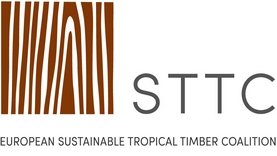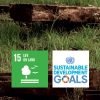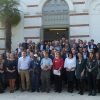Partners promise new insights into sustainable tropical timber trade

George White presenting the project at 2018 STTC Conference. Photo: Mark van Benthem, Probos
The new STTC-backed study of sustainable tropical timber flows into the EU involves a consortium of lead bodies experienced in monitoring the sector and, using new methodologies, promises key new insights into the trade. The goal is greater transparency and more accurate data to aid EU sustainable tropical timber market analysis and better targeting of development initiatives.
The EU Sustainable Tropical Timber Data Partner project is led by the Global Timber Forum (GTF), the international network of associations and timber sector stakeholders, with Netherlands-based forest and timber sustainability advisors and analysts Probos as lead technical partner.
The consortium also includes the ITTO-managed, EU-funded Independent Market Monitor project (IMM), which monitors trade flows and market impacts of FLEGT licensed timber and products from FLEGT VPA engaged countries. It will additionally draw on data from the online Sustainable Timber Information Exchange (STIX), which is being developed by the GTF and analyst Forest Industries Intelligence to improve accuracy of global timber trade flow statistics in support of market monitoring and policy implementation.
Unveiling the project at the STTC Conference in Paris in September, the GTF’s George White said that understanding of the EU sustainable tropical timber sector is limited by the fact that neither FSC nor PEFC collect certification data at source. “Moreover, timber trade federations and importers are reluctant to share their own internal data when there is no obligation and it is not in their interests to do so,” he said. “This currently makes core data collection challenging.”
Focusing on the seven lead EU tropical timber importing countries and primary timber products, the new Data Partner project aimed to achieve better understanding and analysis of their certified tropical timber trade, but also import flows of FLEGT-licensed products and timber from VPA-engaged countries.”
The project breaks new ground in using a measure of ‘exposure to certification ‘market monitoring methodology which has been developed by IMM. Still being fine-tuned, this takes the proportion of certified forest in a supplier country, based on figures from FSC and PEFC, and calculations of productive forest from the UNFAO, and applies that percentage to its exports to specific national markets.
“This method has its limits, but we believe can be refined by, for instance, using timber produced by the supplier country, rather than forest area, and targeted trade and other stakeholder interviews,” said Mr White.
He added that there were clear indications the FSC and PEFC would collaborate with the process, with a further outcome being an improved measure of ‘exposure to certification’ monitoring model that STTC founder and funder IDH, The Sustainable Trade Initiative, could use on an on-going basis.
The project also plans to estimate a ‘carbon footprint number’ for EU sustainable tropical timber trade, blending trade data from Comext and life cycle analysis information from the GABI database. The work is due to for completion in June 2019.
“Finding a cost-effective way to estimate progress in the EU market for certified forest products is an important goal for a wide range of organisations,” said Mr White. “We hope the collaborative effort that this project requires will give us useful results that can be confidently used for on-going monitoring and targeted interventions by a range of stakeholders.”



